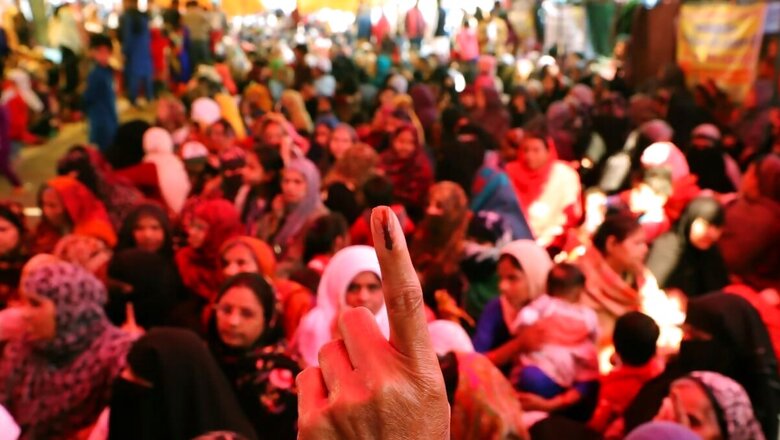
views
The polling for the five Lok Sabha seats — Dibrugarh, Jorhat, Kaziranga, Sonitpur and Lakhimpur — of the northeastern state of Assam in the first phase on April 19 took place peacefully and the turn-out was 75.85 per cent. These seats mostly fall in the tea-belt area of the state. Of these, Dibrugarh, Jorhat and Lakhimpur seats fall in the upper Assam region while most of the Sonitpur seat comes under the north Assam region — with only one constituency in upper Assam. On the other hand, the Kaziranga constituency is divided between the upper and central Assam regions.
These areas are dominated by ethnic Assamese and other indigenous people. In the last two Lok Sabha elections, the BJP won four seats — Dibrugarh, Jorhat, Lakhimpur and Sonitpur. Kaziranga is a new seat formed after the delimitation of the Kaliabor seat, won by the Congress last time. This time, the BJP concentrated on winning all five seats to strengthen its hold in upper Assam and its neighbouring areas.
Issues posing a challenge to the dominant BJP
There has been a narrative across the state pushed by the BJP under the leadership of Chief Minister Himanta Biswa Sarma that no credible alternative exists against it — and Congress’ internal factionalism and the exodus of its leaders have only strengthened this narrative. The tea-belt was also touched by this narrative, giving the BJP-led NDA an edge perception-wise. Having said that, there were certain issues that posed a challenge for the BJP-led NDA in these five seats. The promise of Scheduled Tribe reservation to the six communities —Tea tribes, Sootea, Koch-Rajbanshi, Tai-Ahom, Matak and Moran — by the BJP still remains unfulfilled. This resulted in resentment among these communities. Along with that, the promised wage of Rs 350 for the tea workers by the saffron party too remains unfulfilled. Both the Tea tribes and Ahoms constitute a sizable presence in these five seats. Along with that, there was a feeling against the Citizenship Amendment Act (CAA) among a sizable section in these areas — though how much of this feeling got translated into votes against the BJP itself is a big question as seen in the last Assembly elections. Importantly, this time, anti-CAA agitations haven’t been successful. In addition to these issues, price rise and unemployment were also crucial issues in these five seats. According to the latest Economic Survey, 10 lakh employment seekers registered in employment exchanges in 2022 — a whopping rise in numbers compared to just 1.4 lakh in the previous year.
Nevertheless, the Congress, which had performed poorly in the last Assembly elections in these areas, banked on these dissatisfactions to gain its lost ground in the tea belt. It has to be mentioned that the grand old party announced its support for the ST reservation for the six ethnic communities — this was reiterated by Congress general secretary Priyanka Gandhi during her campaign for the first phase in the state. In the Ahom-dominated Jorhat seat, it had nominated its now-defunct Kaliabor sitting MP Gaurav Gogoi — who has emerged as the party’s prominent face from the region in the Lok Sabha.
Despite all the rhetoric, the BJP did face some resistance as a result of Gaurav’s nomination in the seat, where it re-nominated its sitting MP Tapan Kumar Gogoi. Both were from the Ahom community. But the fight for Gaurav Gogoi was a difficult one on the ground with two party strongholds of Jorhat seat — Demow (earlier Thowra) and Mariani — turning into saffron strongholds.
Welfare schemes, other initiatives likely to have helped BJP
Although the BJP is yet to fulfill its promise of providing Rs 350 as a wage to the tea workers, it is also true that the party after coming to power in the state has raised the wages more than once. The current wage for tea workers is Rs 250. Along with that, direct transfer of money to the bank accounts of tea workers through the state BJP government’s Dhan Puruskar Mela Scheme and various welfare schemes of the Narendra Modi-led government like the Awas Yojana, Ayushman Bharat, Poshan scheme, Jal Jeevan Mission etc were expected to have negated the discontent of Tea tribes and also the other five communities. The state government’s popular women-centric Orunodoi scheme — it provides monthly Rs 1250 to the poor — is also likely to have aided the BJP in the first phase.
Himanta government’s initiative to appoint 1 lakh unemployed youths in government posts along with the PM-Svanidhi scheme — it provides collateral-free working capital loans to street vendors, hawkers and traders — and the various development projects by the Centre are likely to have lessened the negative impact of the unemployment factor for the BJP. It has to be mentioned that Assam is the best performer among the Northeastern states in the PM-Svanidhi scheme.
The delimitation factor
It’s not the CAA, it’s the delimitation factor that is going to have a key impact in this Lok Sabha election. This factor is likely to benefit the BJP-led NDA — and the first too was not left untouched. The addition of the Majuli (ST) constituency, a stronghold of the BJP, in Jorhat, gave an edge to BJP’s Topon Kumar Gogoi over Congress’ Gaurav Gogoi.
Similarly, NDA was well-placed in the newly formed Kaziranga seat, earlier known as the Kaliabor — and it was for this reason the grand old party didn’t nominate Gaurav Gogoi from this seat. Here, BJP’s Kamakhya Prasad Tasa was pitted against Roselina Tirkey of the Congress. Both belonged to the Tea tribe community.
According to Himanta, delimitation has ensured at least 96 assembly constituencies for the ethnic Assamese and the other indigenous tribes dominated Brahmaputra valley — and it was this delimitation that paved the way for the peace pact with the United Liberation Front of Assam (pro-talks). The BJP through delimitation has reached out to the ethnic Assamese and other indigenous tribes — and this is likely to have benefited the BJP-led NDA in the first phase dominated by the ethnic Assamese and other indigenous communities.
Opposition disunity
The Congress-led United Opposition Forum — an extension of the Indian National Democratic Inclusive Alliance (INDIA) bloc — failed to launch consensus candidates in the tea belt. A constituent of UOF, the Aam Aadmi Party (AAP) gave two candidates in Dibrugarh and Sonitpur, while another constituent CPI gave a candidate in Lakhimpur, supported by CPI(M), another constituent of the bloc. Though in terms of arithmetics, these candidates, barring AAP’s candidate of Dibrugarh, mostly were unlikely to have any effect but it brought out the fragmented image of the Opposition in front of the voters — politically a disadvantage for the Opposition in terms of perception.
But the Congress was satisfied that it was able to get the support of two regional parties — Assam Jatiya Parishad and Sibsagar MLA Akhil Gogoi’s Raijor Dal. These newly formed parties have some pockets of influence among the Assamese-speaking population. In Lakhimpur, where already arithmetically BJP was ahead, factionalism was a problem for the party. It nominated Uday Shankar Hazarika against BJP’s sitting MP Pradhan Barua. Unhappy that his wife Ranee Narah — a three-time MP from this constituency — was denied the ticket, Naoboicha MLA Bharat Narah resigned from the party. Naoboicha seat comes under the Lakhimpur Lok Sabha seat.
However, in Dibrugarh, where BJP’s Sarbananda Sonowal, the former chief minister with a clean image, was pitted against AJP’s Luringjyoti Gogoi as the UOF candidate, AAP’s Manoj Dhanuar, a former tea tribe Congress leader, was likely to have dented a fraction of tea votes, including anti-BJP votes. Manoj’s campaign got a boost after Delhi education minister Atishi Marlena and Punjab Chief Minister Bhagwat Mann campaigned for him. Having said that, Union minister Sonowal — who replaced sitting MP and Union minister Rameshwar Teli belonging to the tea tribe community — himself is a popular leader of the state and is likely to have easily sailed through this seat.
One of the political advantages that the ruling NDA had in the first phase was its unity. While the Congress-led UOF was united half-heartedly, on the other side, the allies of the BJP — Bodo-based United People’s Party Liberal, the Assam Gana Parishad and the Mising tribe-based Sammilito Ganashakti Assam, a minor regional party — were seen campaigning jointly for the BJP candidates in the tea belt projecting the united image of the National Democratic Alliance.
Sagarneel Sinha is a political commentator and tweets @SagarneelSinha. Views expressed in the above piece are personal and solely that of the author. They do not necessarily reflect News18’s views.


















Comments
0 comment